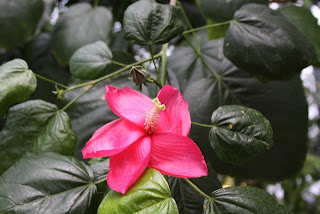Historical Information: Talipariti archboldianum was named after Richard Archbold (1907-1976), heir to early fortunes of the Standard Oil Company. Archbold became an internationally renowned aviator and explorer. From 1929 to 1939, in affiliation with the American Museum of Natural History, he organized, supported, and led four biological expeditions. The first was to Madagascar and then three to the interior of New Guinea. These expeditions are still famous for their comprehensiveness and significance to science.
Monday, March 30, 2009
Talipariti archboldianum
Talipariti archboldianum
Historical Information: Talipariti archboldianum was named after Richard Archbold (1907-1976), heir to early fortunes of the Standard Oil Company. Archbold became an internationally renowned aviator and explorer. From 1929 to 1939, in affiliation with the American Museum of Natural History, he organized, supported, and led four biological expeditions. The first was to Madagascar and then three to the interior of New Guinea. These expeditions are still famous for their comprehensiveness and significance to science.
Talipariti archboldianum (Basionyms: Hibiscus archboldianus Borssum Waalkes, Hibiscus lepidotus Borssum Waalkes) is endemic to the island of New Guinea, and is one of the few Talipariti species with large pink or red flowers (Talipariti ellipticifolium is another). The rose-pink petals are up to 10cm long, and 3.5cm wide. Only Talipariti elatum (with yellow to orange-red flowers) has petals of comparable size. Talipariti archboldianum is a sub-canopy tree up to 50m tall, found growing naturally from lowlands to montane rain forests at elevations up to 2400m (Papua New Guinea has a variety of terrestrial ecosystems including five types of lowland rainforest and 13 types of montane rainforest). Formerly known as Hibiscus archboldianus, this and a group of 22 closely related species in the genus Hibiscus were reclassified by Malvaceae taxonomist Paul A. Fryxell into the new genus Talipariti.
Historical Information: Talipariti archboldianum was named after Richard Archbold (1907-1976), heir to early fortunes of the Standard Oil Company. Archbold became an internationally renowned aviator and explorer. From 1929 to 1939, in affiliation with the American Museum of Natural History, he organized, supported, and led four biological expeditions. The first was to Madagascar and then three to the interior of New Guinea. These expeditions are still famous for their comprehensiveness and significance to science.

